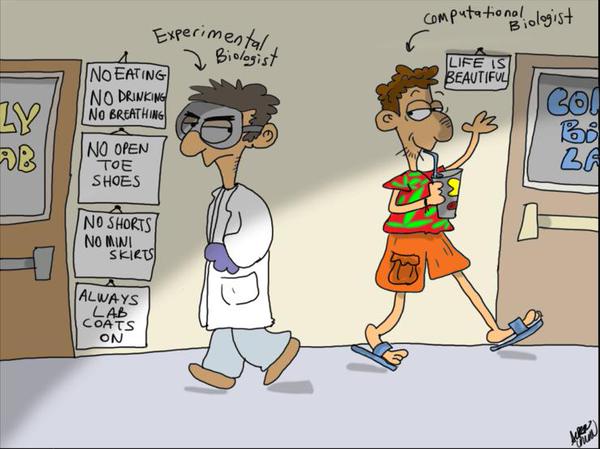Though the public imagery of science is lab coats and test tubes, less well-known is the role of software development in science.
It is often the case that tools don't really exist to do some of the things that need to be done, but after the hard work of creating, testing and validating the code, it only gets mentioned in a line about the roles of the authors that few people actually read.(1)
One great thing about the programming community is that people love to share - the repository known as GitHub is stuffed with utilities, snippets and full-blown programs, but unless you are both a programmer skilled at sight-reading code and a scientist, it can be hard to separate the good from the bad. Like programmers, most scientists love to share, but there hasn't really been a high-profile effort to highlight programs in science literature, even though it's been a hallmark of the Science 2.0 movement since we started it.
Elsevier is filling that gap with SoftwareX, a peer-reviewed journal that treats scientific software as an equal part of the science ecosystem. The "X" refers to the multidisciplinary goal of the journal, to publish software across all science fields. In a way they want to do for code what they did for lab books with their MethodsX publication - fill a gap that everyone agrees has value, if only someone would create it.
And SoftwareX is just a cool name. Anything with an X is cooler. What do you think is cooler, the HMS Pinafore or Battleship X? (2)
 |  |
Exactly.
What intrigued me about the idea, beyond that obvious 'there isn't a journal that does that?' aspect, is probably similar to what might make many of you curious; why would a $3 billion STM division of a large company start a publication like this, when it would be far more profitable to just start a journal called Climate Change North America or something else with a lot more current interest and funding?
The answer is never simple but there is one simple facet; companies are not just interested in making money, regardless of how they get framed. History is littered with examples of where companies make money on a few things or on early adopters and then fund smaller projects or give something away. Global warming and cancer can pay the bills, that allows a new publication to get off the ground without a lot of accounting pressure.
And then sometimes things happen because it has internal champions. Software developers don't get much academic recognition in science, even though they are vital. Without software, there is no high energy physics, estimates are that a third of the HEP community is working on software at any given time, but when papers are written, the code is almost an after-thought. If someone inside Elsevier sees that lack of academic recognition they will also see a reason to fill the need. I picked HEP but I am certain if we talked to computational fluid dynamics researchers they would have lots of tools that have never been shared because there is no great way to share them. Enter SoftwareX.
Elsevier wants to peer review the software tools of science, and also allow for post-publication updates and metadata. Most importantly, in a government-funded world of science, is that those tools will now be easily citable - and consistently available. This is not the personal page of a grad student on a university website, Elsevier is not going away. How many scientists and programmers will be incentivized to share when the benefit of 'open access for peer-reviewed science code' is just as defined as it has been for the data and conclusions? Probably everyone who isn't paranoid about their competition, just like with open access data.
Still, it is hard to ignore the money aspect. The reason is obvious; everyone says they want something, but getting people to pay for it is difficult. I spent $1 million evangelizing Science 2.0 and universities in Germany will happily steal all of our good will to rip off attendees by selling conference tickets using the Science 2.0 name. Schools will not pay if they can avoid it.
Money may not be everything but it can't be nothing.
So to find out what Elsevier thought about the money and other things I sent an email to Dr. Eleonora Presani, publisher for the new journal. The HEP analogy turned out to be quite apt because in her former career she was a high-energy physicist. Anyone in experimental physics knows that you don't really work with inverse femtobarns - it is a thousandth of a millionth of a millionth of the cross-section of a uranium nucleus - physics outside the hypothetical multiverse stuff is very software-intensive, it is interpreting trillions of collisions. Yet aside from "Higgs found!" and a GeV chart, no one outside experimental physics will know how that work was actually done.
Presani said what you might expect about the role of scientific publishing being to facilitate research and be acknowledged by peers, but then surprised me with the practical aspect: "I don’t really think that scientific software is not a big market, I think it has a huge potential, since more and more people in the scientific community use and develop software as an integral part of their research."
It certainly could be. Elsevier did not get where it is by doing the journal equivalent of one of those Mickey Rooney-Judy Garland "let's put on a show!" movies, they instead did what actually happened to create those Busby Berkeley musicals; a lot of talented, smart people all working together and being creative and giving the audience what it wants.
That doesn't mean money and good things can't happen together. Contributions are "peer-reviewed and considered "one body of work" for citation and indexing purposes", which is needed and probably going to be popular because of the stamp of legitimacy Elsevier brings. And while Elsevier will store it, the owners still own it. It's Open Access and published under CC-BY license but contributors get to pick the license.(3) No one gives up any copyright transfer for the software or the article.
Aside from 'is this a market?' the other big question is, how is peer review done? There is a template for reviewers but Presani fleshed it out in more practical terms. "Code is peer reviewed giving the highest importance to evaluating the scientific impact of the software. While the author should prove that the software compiles and runs correctly, the journal really focus on evaluating the impact that a piece of code has on science."
Which is the same as just about every science paper.
"I don’t see it very differently from a normal research article. While reviewers judge the scientific impact of the discovery, it would be impossible for a single person to understand on the ins and outs of a research such the one of the discovery of the Higgs boson, for example."
As of the time of this article, SoftwareX is just getting ready to publish its first set of peer-reviewed articles and code. I am curious to see the response. I would expect that the more numerically intensive fields, like physics, will show a lot of interest. I know when I was in the corporate world of physics software, lots of academics would say they could do a better job than we did.
Here is there chance to show it...and get some academic recognition also.
NOTES:
(1) However, the rest of the time the people who work on computers have a pretty sweet deal.

Credit: BioComicals
(2) Or demographics. Surely Generation X is cooler than Millennials, because Generation X had Billy Idol while Millennials have an alarming number of lumbersexuals:
 |  |
Generation X band credit: Chrysalis Records. Anti-science millennial hipster via Science Ally
(3) The SoftwareX list of recommended open software licenses:
• Apache License, 2.0 (Apache-2.0)
• BSD 3-Clause "New" or "Revised" license (BSD-3-Clause)
• BSD 3-Clause "Simplified" or "FreeBSD" license (BSD-2-Clause)
• GNU General Public License (GPL)
• GNU Library or "Lesser" General Public License (LGPL)
• Mozilla Public License 2.0 (MPL-2.0)
• Common Development and Distribution License (CDDL-1.0)
• Eclipse Public License (EPL-1.0)



Comments